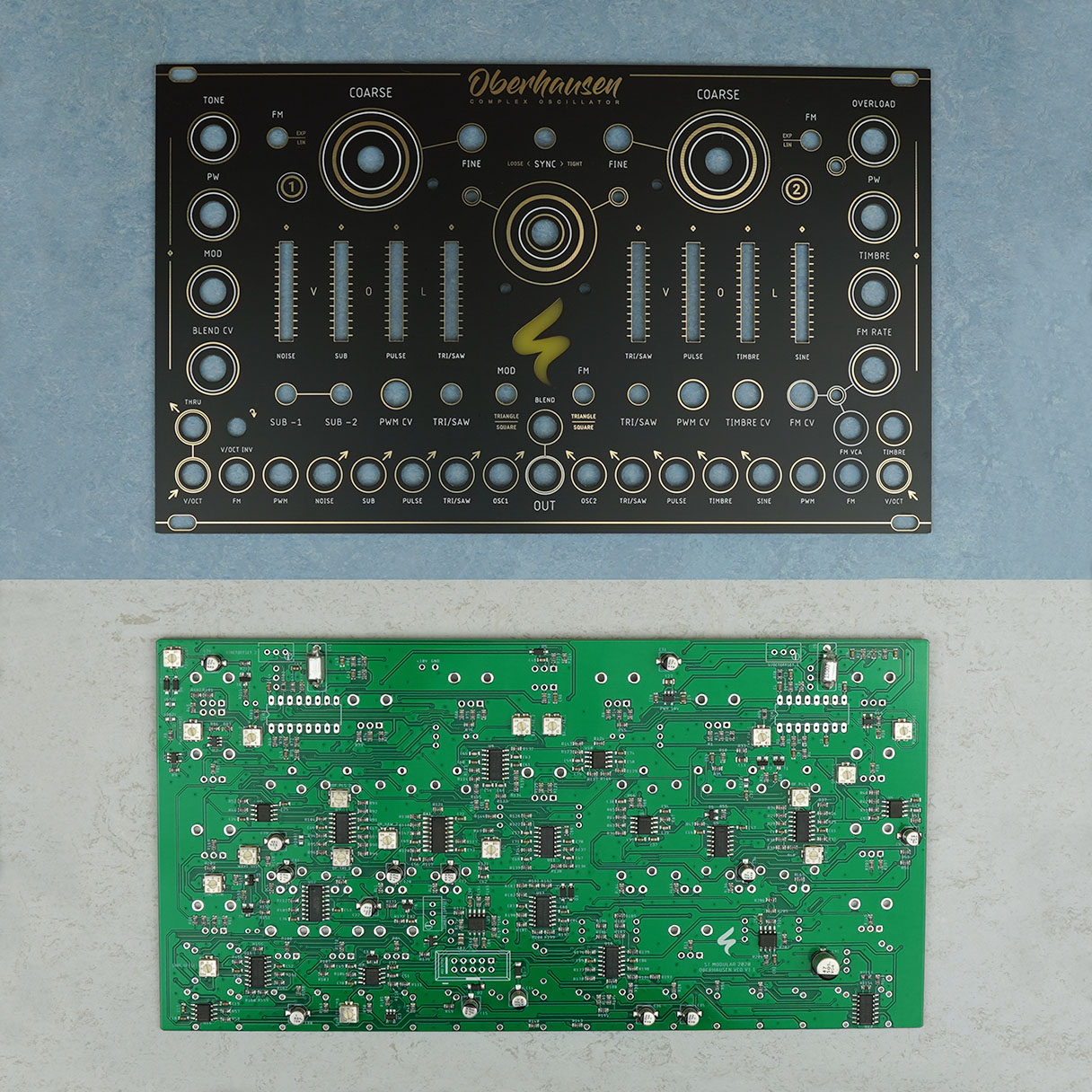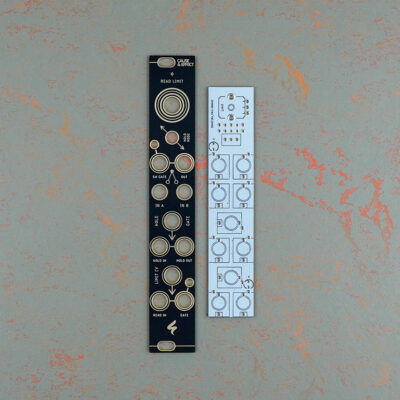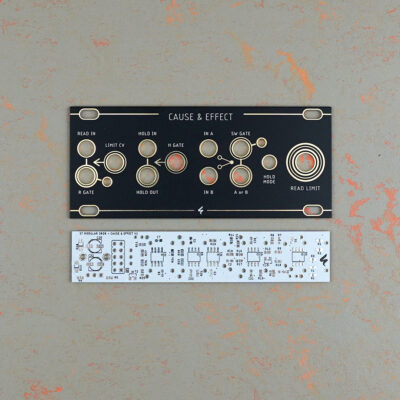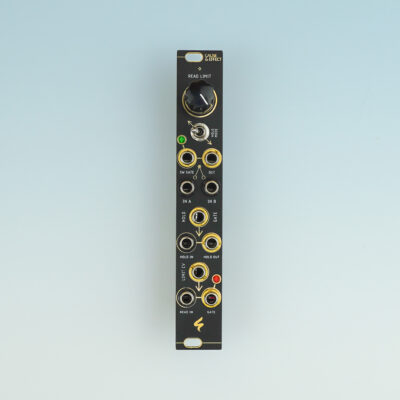Description
Complex Oscillator
OBERHAUSEN is a CEM3340 based Dual Voltage Controlled Analog Oscillator designed to create a wide range of complex waveforms. It wasn’t designed to offer the most perfect waveforms, but definitely ones with lots of character and grit. OBERHAUSEN features two principle oscillators and two modulation oscillators. Both principal oscillators offer five different waveforms. Each waveform´s level can be adjusted with a dedicated volume slide potentiometer and is available at a separate output jack. The sum of the OSC1 and OSC2 waveforms can be blended either manually with the large potentiometer in the middle of the module or via CV and is available at the main OUT socket. Each sum is also supplied at the OSC1 and OSC2 output jacks separately (after BLEND).
OSC1 (Principal Oscillator)
NOISE – White Noise with a fixed high pass filter at 320Hz.
SUB – Two Sub-octave waves based on the SAWTOOTH waveform. They can be activated individually with the SUB -1 and SUB-2 switches.
PULSE – PULSE waveform with adjustable PULSE-WIDTH via PW knob or CV with a dedicated attenuator PWM CV.
TRI/SAW – Either a TRIANGLE or SAWTOOTH waveform according to the TRI/SAW switch.
TONE – Accentuates either low or high frequencies of all OSC1 waveforms.
FM – FM input for either EXPONENTIAL or LINEAR FM, adjustable via FM switch (mid position is off).
V/OCT – 1V per octave input and a precision duplicate output of the incoming CV signal for further external processing.
FRONT PANEL CALIBRATION & GAIN – A trimmer potentiometer for V/OCT tuning and OSC GAIN is located on the front side of the module.
OSC2 (Principal Oscillator)
TRI/SAW – Either a TRIANGLE or SAWTOOTH waveform according to the TRI/SAW switch.
PULSE – PULSE waveform with adjustable PULSE-WIDTH via PW knob or CV with a dedicated attenuator PWM CV. OSC1´s PWM CV input is normalized to the OSC2 pulse-width modulation input.
TIMBRE – Buchla inspired timbre generator. The timbre setting can be changed with the TIMBRE knob or via the CV input with an attenuator.
SINE – Pure and analog SINE wave.
FM – Either EXPONENTIAL or LINEAR FM, adjustable via FM switch (mid position is off). Can be generated internally or via external CV.
FM VCA – The FM input´s amplification can be controlled via an internal VCA. As soon as a jack is plugged into the FM VCA input jack FM modulation will only be applied in accordance to an incoming CV signal (such as an LFO or Envelope Generator).
OSC SYNC – OSC2 can be loosely or tightly synced to OSC1.
OVERLOAD – Feedback Distortion with Clipping LED for all OSC2 waveforms.
V/OCT – Separate 1V per octave input. OSC1´s 1V/OCT signal is multiplied via a precision buffer and normalized to OSC2´s 1V/OCT input, if no jack is present at the OSC2 V/OCT input. This routing can also be deactivated with the V/OCT INV switch. Additionally the normalized V/OCT signal can be inverted and routed to OSC2, if the V/OCT INV switch is in the down position.
FM OSC (Modulation Oscillator)
FM OSC only modulates OSC2´s frequency. The RATE can be set with the FM RATE knob. The oscillator´s waveform can be changed from TRIANGLE to OFF to SQUARE WAVE with the FM switch. The amount of modulation applied can be adjusted with the FM CV attenuator, if no jack is plugged into the FM input jack. An LED indicates if FM modulation is active taking any FM VCA modulation into account. With the help of the the FM switch the modulation type can be set to either exponential or linear.
MOD OSC (Modulation Oscillator)
The MOD OSC is a low frequency oscillator that internally controls BLEND CV, OSC2 TIMBRE CV and OSC1 PWM CV (which is normalized to OSC2 PWM CV). Its RATE can be adjusted with the MOD knob and the final depth is set by the destination CV attenuators BLEND CV, PWM CV and TIMBRE CV. The oscillator´s waveform can be changed from TRIANGLE to OFF to SQUARE WAVE with the MOD switch.
MIX & BLEND
In order to mix both principal oscillators and their waveforms OBERHAUSEN features two 4-channel mixers and a additional blend mixer. With the help eight dedicated slide potentiometers each waveform´s level can be set. Additionally you can blend between OSC1 and OSC2 either manually, via CV at the BLEND input jack or internally with the MOD OSC and BLEND attenuator.
Details:
• Analog Complex Oscillator
• 2x CEM3340 based Principal Oscillator
• 2x Modulation Oscillator
• 8x Waveform Output
• Mix Waveforms with 8 Slide Potentiometers
• Blend Principal Oscillators to One Main Output
• Create a Wide Range of Different Waveforms
• Skiff Friendly
• Wrong Polarity Protection
https://www.st-modular.de/modules/oberhausen
- 110 mA +12V
- 90 mA -12V
- 0 mA 5V
- 28 mm deep





